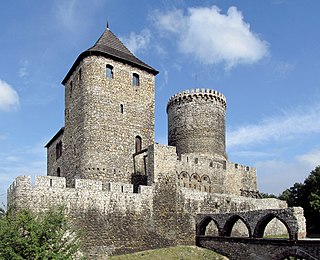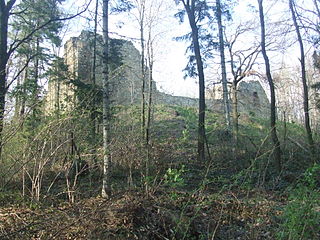
The Royal Castle in Warsaw is a state museum and a national historical monument, which formerly served as the official royal residence of several Polish monarchs. The personal offices of the king and the administrative offices of the royal court were located in the Castle from the 16th century until the final partition of Poland in 1795. Situated in the Castle Square, at the entrance to the Old Town, the Royal Castle holds a significant collection of Polish and European art.

Pieskowa Skała is a limestone cliff in the valley of river Prądnik, Poland, best known for its Renaissance castle. It is located within the boundaries of the Ojców National Park, 27 km north-northwest of Kraków, close to the village of Sułoszowa. The castle was first mentioned in Latin documents of Polish king Władysław I the Elbow-high before 1315, as "castrum Peskenstein".

Krasiczyn Castle is a Renaissance castle à la fortezza in Krasiczyn, southeastern Poland. It stands on a lowland at the right bank of the San River, along the Przemyśl-Sanok route and some 10 kilometres southwest of Przemyśl.

The Nowy Sącz Royal Castle is a mediaeval castle in the city of Nowy Sącz in Poland. The partially restored ruins of the castle date back to the 14th century during the reign of Casimir III the Great.

The Będzin Castle is a castle in Będzin in southern Poland. The stone castle dates to the 14th century, and is predated by a wooden fortification that was erected in the 11th century. It was an important fortification in the Kingdom of Poland and later, the Polish–Lithuanian Commonwealth.

The Lublin Castle is a medieval castle in Lublin, Poland, adjacent to the Old Town district and close to the city center. It is one of the oldest preserved royal residencies in Poland, initially established by High Duke Casimir II the Just. Its contemporary Gothic Revival appearance is largely due to a reconstruction undertaken in the 19th century.

The Lviv High Castle is a historic castle located on the top of the Castle Hill of the city of Lviv, Ukraine. It is currently the highest point in the city, 413 metres (1,355 ft) above sea level. The castle currently stands in ruins.

Łańcut Castle is a complex of historical buildings located in Łańcut, Subcarpathian Voivodeship, Poland. Historically the residence of the Pilecki, Lubomirski and Potocki families, the complex includes a number of buildings and is surrounded by a park. The castle is one of Poland's official national Historic Monuments, as designated September 1, 2005, and tracked by the National Heritage Board of Poland.

The Royal Castle in Warsaw was a seat of the Sejm and Senate of the first Rzeczpospolita and also an official residence of the monarchs in Warsaw. It contained the offices of a number of political institutions, arranged around a central courtyard.

Kreva Castle is the ruins of a major fortified residence of the grand dukes of Lithuania in the village of Kreva, Belarus. The village lies 220 metres (720 ft) above sea level.

The Sandomierz Royal Castle is a medieval structure in Sandomierz, Poland. It was built on a slope of Vistula River by Casimir III the Great and extended in the 16th century. The original building was blown up in 1656, leaving only the west wing standing. It was later transformed into a Renaissance styled residence with the west wing preserved as a museum.

The Łęczyca Royal Castle is a medieval castle in Łęczyca, Poland, that was erected by Casimir III the Great as a fortification during 1357–1370.

Niepołomice Royal Castle is a Gothic castle from the mid-14th century, rebuilt in the late Renaissance style and called the second Wawel. It is situated in Niepołomice, Poland and was extensively reconstructed in the 1990s.

Przemyśl Castle or Casimir Castle is a Renaissance castle in Przemyśl, Poland, located on the Castle Hill, which rises to a height of 270 metres above sea level and 70 meters above the city and the San River.

The ruins of Czorsztyn Castle are located in the southernmost part of Poland in Czorsztyn, at Czorsztyn Lake within Pieniny National Park borders. On the other side of the Czorsztyn Lake is located Niedzica Castle.

The Lanckorona Castle was built in the early 14th century in Lanckorona, Poland. It was damaged in several fires and during conflicts, especially in 1655 during the Swedish Deluge and Battles of Lanckorona in 1771. Jakub Derc led a peasant revolt and was killed in Lanckorona.

Toruń Castle is a 13th- or 14th-century castle of the Teutonic Order located in Toruń, Poland. The castle is part of the Medieval Town of Toruń, one of the World Heritage Sites in Poland and Historic Monuments of Poland.

Uniejów Castle is a 14th-century bishops' castle located on left bank of the Warta River in Uniejów, Łódź Voivodeship, Poland. It is considered one of the main places of interest in the town.

Oleśnica Castle is a castle in Oleśnica, Lower Silesian Voivodeship, southwestern Poland.
Horodok Castle, also known as Gródek Castle was a fortress situated by the river Smotrych.



















